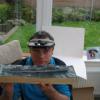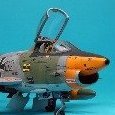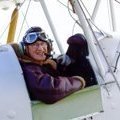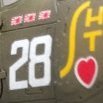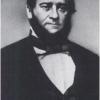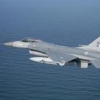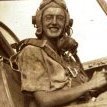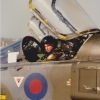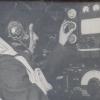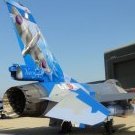Leaderboard
Popular Content
Showing content with the highest reputation on 23/09/17 in all areas
-
Very nice kit, used Aviaeology Decals, Brengun PE air intake, Ultracast propller and spiner Tamiya Paints.29 points
-
I’ve built Sabres before, but this is only the second one I’ve done in BMF. Standard Hasegawa kit with Warbird decals. This is an F-86F-1 that had the 6-3 wig kit fitted late in the war.20 points
-
This had been sat in the stash for a bit and I needed a small fill in kit and this on fitted the bill I did I straight out of the box and for a small one I enjoyed the build.18 points
-
This is a subject I've been wanting to do for sometime! The 352nd FG were one of the leading FG's in the 8th AF based at Debden and gained the nickname 'The Blue Nose B'stards of Bodney'. Lt Edwin Heller was amongst the leading aces from that FG and scored more ground kills than any other pilot in the 352nd. He was one of the first in the FG to have the Malcolm hood fitted to his P-51B/C, due to him being quite tall. The kit is nicely detailed and has the all important wing leading edge kink about right which is the biggest error in some other P-51B/C kits. The kit was built oob, except for the Eduard seatbelts and KP's own resin drop tanks and wing racks and was painted with Vallejo paints. I dedicate the build to Jan Polc of AZ/KP Models, who has helped out with some things! thanks Mike16 points
-
Hi all. I'd like to show my latest build. This time it's the 1/48 Revell Eurofighter Typhoon. Quite a nice kit with very nice details like the ejection seat and the rest of the cockpit. With a rivet wheel I added rivets on the wings and tail. The main coclor gray is from Akan and the other colors from Gunze. All over a black primer from Alcad. The metals on the exhausts are also from Alclad. Thank you for watching. René14 points
-
I started this kit several years ago and unfortunately it found it's way to the shelf of doom. However, I dusted it of for just such a group build over on LSP as this is an aircraft far too nice looking to let sit half built...and it was an expensive model!! The kit has excellent detail straight out of the box, fit is ok, probably one of PCM's better, but it still requires a little elbow grease to get everything fitted nicely. The decal sheet is really nice, although I didn't use any of them, rather I used my compass cutter and some red stars from the spares box for the Syrian insignia. Overall I'm happy this is now done and sitting in the cabinet.14 points
-
I'm wondering a lot about the wonders myself. So far it hasn't exactly been wonder-full. More eye opening than anything. This is my first experience with a kit from a let's say - non major manufacturer and so far I'm finding it a real mixed bag. I like the fact Fly released a 1:32 version. I like some of their detailing. I like how the panel lines are very light - much more refined than others I've come across. I don't like the plastic - it is ridiculously soft and small parts are prone to bending. As I mentioned previously - there is a LOT of flash. Flash on pretty much every part to some extent. There is also a mold mismatch, and some decidedly iffy engineering. For example - take a look at this part (one of the internal frames). Notice anything ? Well, Fly appear to have attempted good molding practice by machining a full round runner, with half round in the A side and half round in the B side, unfortunately someone couldn't follow the 3D model (or a drawing). There are three runners and gates on this part - the one on the extreme left is good -both sides of the runner match up. However, look at the one on the extreme right - the upper and lower half of the runner only partly align. Then look at the center one.. they completely miss each other. You may also see a faint horizontal line running along the length of the part - that's the result of the mold mismatch. Now, while that may not seem so bad, that will affect how the mold fills and will also affect how much they can pack the mold. I think this and other 'features' like it are contributing to the flash I'm finding everywhere. At a guess, I'd say the mold wasn't filling as they expected/hoped - and they just kept packing the snot out of the mold until it filled, resulting in the flash. Here's another example. This is a relatively new mold so you would expect that edges would be nice and sharp, yet look at how that edge is all wavy and has flash protruding here and there. I think that's the result of over packing, though it's possible poor machining has contributed to it. In between frequent bouts of non modeling activities, I did manage to get a few bits glued together. Namely these... I had to sand the edges down to try and get a good butt joint, but could only take the plastic down so far. I was getting close to losing detail so I stopped when I thought I had the best joint I was going to get. I then used a couple of strips of masking tape to cover the detail leaving only the joint visible - which then good a good slap of filler. Then once micro-meshed back, the seam looks acceptable. Another thing I like about the kit is the fact that the locations of the frames and stringers are marked on the inside of the fuselage. What I don't like is how vague the instructions are regarding said locations. The location is marked with a single faint line... so far so good. What they don't tell you is whether the frame goes behind the line, in front of the line, or on top of the line. After probably another hour of dry fitting and taping bits together I took a swing at it - still convinced I am right though. I also found that the frames were very flimsy, and difficult to keep straight. Then, once you placed the part beside the line, you could no longer see the line. My first attempt involved super glue and I really wasn't happy with the result so they were all peeled off again. Second time around I used poly cement and used tape to act as a visual guide for placement of the ribs. Much better but still not perfect. Finished result here and you can see that some of the ribs are a bit wonky towards the bottom end. I reckon trying to remove them again will cause more damage so I'm accepting it and moving on. The bottom of the ribs will be covered by ducting so won't be visible (otherwise they would have been removed again) Some very debatable detail is present on the cabin rear bulkhead. I'm really not a fan of the 'quilting' - looks more like a tiled floor than a flexible cover. Luckily, I have some of that tinfoil left over from first time around which I think I will end up using again. The 'quilting' looks about the correct scale. This was just a quick test to see what it would look like. I need a better backing material so I can get some flex and creases into the door cover. I may also have to remove the molded on door to make it look a bit better. Not a lot of progress, but at least it is some. I've probably spent more time dry fitting on this than I have actual modeling.14 points
-
Hi all. I'd like to show my one of latest build. This time it's the 1/48 Trumpeter F-100C Super Sabre. A very nice kit I must say. Fine surface details and good fit. The decals are also very nice to work with. I wanted to recreated the stainded paint on the rear fuselage. First I used several metal colors from Alclad and used Tamiya clear red and blue and weathering set D to recreate the burned metal. The colors are from the Hataka orange acrylic range, all in one nice Vietnam era paint set. Thank you for watching. René13 points
-
Nice model to build, cockpit tub need some care in order to the fuselage halfs glue easily.13 points
-
12 points
-
As someone who hasn't made a model for pleasure for over 35 years, A few weeks ago I received a challenge from an accomplished Scottish modelling friend. He makes 1/48th dioramas of those delightful small civil lightplanes of the 1930's -40's which I love so much. The challenge was for me to dig into my loft and build something for pleasure. He had just completed an out of the box 1/50 Heller Stampe and so I've elected to do the same. Well almost! I duly dug out my Stampe box and some helpful books and I started to give it the once over. Mistake number one. My kit is moulded in red plastic which should have shouted 'Danger don't take it out of the box'. I'm a bit rigid with scales but I was prepared to accept 1/50th had it been an accurate kit but it soon was apparent to me that it wasn't. So out came the Stampe Albums... The Stampe et Vertongen SV-4 had it's distant origins in a DH licence to build Gipsy Moths in Belgium in 1930. Like other Moth Licencees (such as Caporoni) the Stampe meta-morphed into a quite different aeroplane. Though similar to the Tiger Moth, but of all wooden construction and powered by the same Gipsy Major engine (SV-4B), it had a more refined wing section and ailerons on both upper and lower wings that suited it to aerobatics, in which it excelled. Post -war the major production was in France mainly for the Armee de l' Air and Aeronavale and powered by a Renault 4P engine. (SV-4c) The Heller kit (made in France) is a SV-4c and the kit must be nearly fifty years old. So what's wrong with it? Err, OK what's right with it. Nothing! Even for 1/50th the top wing is about 3 mm too short and centre section fuel tank is missing. The lower wing is 10 mm too short and the wing tips are the wrong profile as is the rudder. The under-carriage main legs are much too short and the fuselage too narrow. The wheels have the wrong section, need I go on. So what was I going to do? Think's I'll convert it to 1/48th scale. I had already placed the fuselage over the 1/48th plan and I noted that if I inserted a longitudinal 2 mm strip of plastic into the fuselage to widen it vertically, then it was game on. I was going to use one of my Tiger Moth engine cowls, but I found in my home workshop an old vac mould for a Smer Tiger Moth nose conversion I did before the last Ice age. The fuselage also required widening and this was done by adding plastic strip around the inside of both halves. It also would require minor length mods and a prominent fuselage stringer along the sides. It also needed more stringers along the rear turtle decking. The plan was to to use Slater's hard plastic rod the form the rear stringers and clad the cockpit area in a wrap of sheet plastic. The rest of the fuselage sides would then be covered in Milliput which would be smoothed down to represent the fabric areas. Finally, after wet forming the Milliput the fuselage was coated with Halfords spray Primer -Filler. The cowl is just perched on for effect and isn't at quite the right thrust line. More anon. John10 points
-
Hello all, here is pair of Dragonflies that I built several years ago. Thai one is Academy (+Extratech etch) and Dominican one is old Hasegawa (with positive panel lines). Both completed with Agama alcohol based colors and Albatros Modelworks decals. They still missing whip anthenas, I have to force myself to add them some day Link to hi-res photos here9 points
-
I must apologize for any impression I may have given Mr.P that I am anything but an occasional rock-knocker. Geology fascinates me but the hammer is a relic from when the boys were young and fossil hunting along the Jurassic Coast was an annual expedition. Where I currently live is a rather dreary limestone basin rubbed by the glaciers into eskers and clays. If there was any social justice then Dr.Ian West would have received a knighthood long ago for services to the Wessex coastline: http://www.southampton.ac.uk/~imw/ Such are the webpages that a gentleman scientist could have put up on the Victorian internet in the last century, full of scientific observation and wonder at the depth of time made visible... I believe gentleman that a colourful rallying-point at the show has now been made manifest! Ced, Keith, Bill: maybe as Keith suggests we could arrange a time to hook up at the Brum table and/or adjourn for a nearby coffee? As Bill says it's near the entrance, plus being a complete novice at this event, may stop me wandering off and witlessly becoming embroiled in some weird LARPing display of young conservatives vs. hobbits... We've a whack of time to hash this out anyways if anyone has better notions. Quite so Simon! I take this as proof that modelling is a natural and healthy condition, given the way it gradually absorbs more and more elements of the home environment, like a benign vortex. You are most kind for saying-so Jaime, but for the most part I'm simply passing on what others have taught me (either directly or indirectly) in the way of skills and techniques. Ta Martian. Do they keep the hall well-heated? I'm torn between Crinoline and Voile at present.... Tbh I don't know who was most excited about going over when we were booking the tickets yesterday, me or my youngest lad - for whom it means a bunk from school. Mercifully there aren't fines here yet for that sort of irresponsible parenting <ahem> moving on.... We're at bulkhead 14 now and rolling along quite nicely, even if I do tempt the Fates by saying so: Some detailing and rivetting, plus two holes bored out for some - what I can only describe as 'quite theatrical' - pipework! It's worth digressing briefly at this point in order to explain region bit because of both the exuberant nature of the plumbing in this part of the aircraft, and the amount of dodgy translation it took me to work out what the hell was going on. Sitting comfortably? Bulkhead 14 sits at the rear of the tankroom and on the rearward facing side of it (symmetrical on either side) are the pipes of a Gothic church-organ. Well, they're not obviously a church organ of course, but you do rather expect to find a passage in the flying notes that relates how upon sighting a convoy, the flight-engineer is to rush to the organ and begin loudly playing - Captain Nemo style - selections from Wagner's Parsifal as they swoop in on the attack run. Possibly. Anyway. Turns out that these pipes are apparently a rapid fuel venting system (schnellablankanlage), consisting of an ablassventil (drain-valve) passing down through the bottom of the floor, which is connected to an ablassrohr (discharge tube) running vertically up to the top of the bulkhead and back through into the fuel tanks on either side, where it mates with an belüftungsventil (tank valve). Powering the system is a vakuumgebläse (vaccuum blower) mounted centrally on the bulkead at the top, connected to both sets of discharge pipes by a saugleitung (suction line). Got that? 30 amp fuse wire did for the main tube runs at this scale. Of course the only bit I could find was pretty mangled so I straightened this outwith the old steel-ruler-rolling trick before a final tighten between pliers: The parts were then cut to length and the lower curvature added where they meet the vent at the bottom: I filed the cut-ends square again after taking this shot so that they would mate properly with neighbouring parts. Thence it was to the solder station to beging fabricating the main parts: 0.3mm brass tube for the messgerät (measuring gauge) that sits off to one side halfway up, 0.8mm tubing for the drain valve at the bottom (mostly buried in white tack in the photo above). Cleaned-up: Not complicated, just fiddly in terms of keeping both port and starboard pipeworks symmetrical with each other. He we are now with the first one added to port: You can see the way the pipe comes in from the tank room behind the bulkhead and then goes out through the floor of the laderaum (cargo space). Over to the right in that photo you can see the starboard one back in for repairs due to 'enthusiastic' cleaning-up with a file... Both in place now, with some 5 amp fuse wire inserted at the bottom of the measriung gauges in order to form the connection to the main pipe: I've also added the central vaccuum pump/blower above the doorway at this stage as well: There are/were it has to be said some finer details and wires etc. on the real thing, but what I've tried to do here is express the overall feel of the shape and structure, given problems of scale (simply building things bigger than they are in reality, so that they don't break off, but looking 'wrong'), and also the not irrelevant fact that when buttoned-up, the only way this pipework will be seen at the end is through a tiny porthole, if at all.... I have no more for you today. Hope you all have great respective evenings. Tony9 points
-
Thanks Jaime Thanks Bill, I think Any dihedral in the tailplane has been caused by the struts... They look OK and only a bit tilted and I can't be bothered to re-glue them with shortened struts. Worth pointing out though to modellers who want to get it right, rather than just finished. Canopy blended and other bits filled with black Milliput: Untitled by Ced Bufton, on Flickr I can see why Nigel likes this stuff for canopy blending - it's almost impossible to see the join! Hopefully it'll be OK when the paint goes on. By the way, those 'ejector marks' on the bottom aren't - they're locating points for the struts. Honest. I think. Good job I didn't fill them in...8 points
-
Hope you're all having a nice weekend. Once again life gets in the way of plastic. This was last night. This morning however it was my turn to get up with Zero so I decided to see if I could follow TT's build on a tray idea from last year. So all the bits got piled onto an old tray and transplanted into the kitchen or as it's known now, "The lair of the hound"not a bad set up really. so to begin with all the windows got glued in as did this bit at the rear. There's meant to be a gun inside but to say you won't see it is an understatement so I did without. the bulk head where I stuck the lead was visible typically from the canopy. I'd painted the lead sheet but it looked odd so I made a little shelf that blocked the view and painted it. Then I finally gat the sides buttoned up. the well had to ged pegged in place as the fit was a bit off. It pulled the other side out of line. this will be temporary because of the peg force. "PForce" I wonder what that should be an actual measurement? I had to break for hound duties. then back to it. i didn't have my berna clamps down here so I used tape. Aaaaaand pegs. The nose was a bit of a pain but I managed to pull it in line. The steering wheels got fitted too. Tail fins got glued. and a trio of wheels. I think someone's bored. Eventually the family woke up and breakfast ensued. Im back in the cave now, tape off and a wee bit of sanding. A little Mr S and I'm out for a walk and lunch. take care every one. I'll look forward to catching up with your builds later on. Happy Modelling chums. Johnny.8 points
-
Thanks, Buffers! So far. I learned at an early age that nothing I ever did was good enough for Jehovah, which proved to be an excellent preparation for marriage. I've had a day and a half, gentlefolk. I crawled into bed last night a little past midnight, so foolishly I tried to eke out twenty minutes extra sleep this morning. While I was thus reposing, Mrs P was left alone with Winston and Grant. While the latter pooped, the former took advantage of Mrs P's distraction to scale the kitchen table, sit in the baby's little rocker pod that was up on it, and then go over the side, really hard. It probably looked a little something like this: Winston then started sobbing, which, okay, fine, kids do that, and then vomiting, which, no normally they don't. So I awoke to Mrs P shouting "EDWAAAAAARD", ran downstairs, was handed a bare-rumped Grant, and then saw Mrs P out the door with Winnie. Oh, and we were taking the car in to be detailed and purged of two years worth of accumulated snacks caught in the crevices of the back seat, so all the carseats were removed. It was that kind of morning. And Mrs P forgot her cell phone. Ultimately I hitched a ride over to the hospital emergency room (god knows how much this will cost us, in The Finest Healthcare System In The World) and Winnie was okay, but it was a fraught few hours. Here he is at the hospital. He tried to throw himself off the bed a few times, principally for the novelty of it, I suspect. Here's why our healthcare is so much more expensive than yours: supply wastage. Mrs P bore the whole thing pretty well (image only very slightly digitally manipulated): But after all of this, she was very drained (and informed me in incredibly vulgar terms that a part of her anatomy was hurting quite a bit), so I took Winston on a dad date to a local hot dog place: As Chicago's a city of artery-blocked fatties, the thing we do better than anyone else in the world is make things to make ourselves even fatter, and the Chicago-style hot dog is a triumph of this art. Every part of it is designed to protect a fragile mind from identifying that it's eating a hot dog, or contemplating what might go into a hot dog casing. The Mean Wiener, where I took Winston (and where I'll happily take you, if you come to this blighted land) does an amazing one. It also makes milk shakes, and, my reasoning mind overcome with love for my greatest creation, Winston got one: I paid a bitter price for this later, as it went through him like armour-piercing bullets through a goose. But the less said about that the better. ANNNNNNNNNNNNNNYWAYYYYYYYYYYYYYYYYYYYYYYYYYY Got a little more done on the RWD-8 today. Masked the metal areas off and started on the khaki colour. Still more to do, but reasonably happy with my progress so far.8 points
-
Decision made: Port aileron slightly down (and though it looks here as though the port nav light isn't properly aligned with the wing, that's an optical illusion): So obviously starboard slightly up: …and we have a Seafire really taking shape now (and, by the way, kudos to 90s Airfix, because with a little bit of care the fit is excellent): [The spinner is just dry fitted - it was one of the pieces that had been started by this kit's previous owner - and to be honest he'd made a bit of a bodge of it, so it needs a fair amount of work] Happy Crisp7 points
-
Et viola the wanderer returns With an almost amorphous shape blasted out of solid plasticene And Frog/EasternExpress propellor spinner pieces First cast of several which I will use to make spinners (x 2, there will be two Gannets here later) that are properly closed round the prop bases unlike the cavernous spaces left behind by Mr Rovex, back in the day You can sort of make out where the plasticene got to can't you Oh well down into the casting shop now to begin the next ones, ciao6 points
-
In case anyone is confused, this is the photo to which @Fritag and I are referring: On reflexion, I think you might have a point about control locks - both the two nearer aircraft have their elevators hard nose-up. You can just see that the third aircraft from the camera has its elevator nose-down, but just as I was about to comment I realised that it's a Mk.17 (different tail / rudder profile, & single prop) - and the furthest away (another Mk.46) you can't see either way. Considering how short a time these aircraft were in service, there is a surprising amount of wear / weathering around the cowlings and the pilot entry doors. These young thrusters are all RNVR (1832 was a Reserve squadron), but judging by the medal count they had flown a fair amount during the war! I assume the 2 & 1/2 in the front row is either the CO or SPLOT, and he appears to be well into his fourth row of medals… [I have also only just noticed the Firefly just visible at far left, above the fuel bowser.] [By the way, any Spitfire experts out there: is that thing sticking up out of the wing (just by the left foot of the rating refuelling the aircraft) one of the rods that gave a visual indication of the wheels being locked down? I have obtained a copy of the pilot's notes, which talk about this still being fitted despite there being an indicator light inside the cockpit. If so it looks rather larger than I anticipated!] As I said, there aren't that many extant photos of Mk.46s in squadron service (mostly because they didn't serve with many squadrons, or for very long, being an interim design awaiting the FR47). This next one was, I suspect, taken during the same visit to 1832 NAS: I think that's interesting because the elevator is still quite nose up, even with a pilot on board and his engine running - might be more to do with keeping his tail down? Finally, the tail of LA541, one of the Mk.46 prototypes - one of those "official" Farnborough / Boscombe Down portrait photos of a new aircraft type. I think what we're basically saying is that I can pose the elevators pretty much how I like, up to and including full deflection! Not wooden and central, anyway! What a beautiful aircraft, anyway. Probably heresy to many, but I have always thought the long nose of the Griffon Spit/Seafire made it look even nicer. I remember building a ?Revell Mk.XIV & Flying Bomb kit when I was a boy; that was the first time I consciously realised that Spitfires didn't all have short noses and 3-blade props - I recall even as an 8- or 9-year old thinking that 5 blades and that aristocratic nose made it look incredibly cool; I think contra-props might have blown my young mind altogether! More modelling later Crisp6 points
-
Eduard spitfire mkviii Clive Caldwell's machine Thanks for a good group build everyone and onto the next! Joss6 points
-
As you can all tell Sywell was a nogo but instead I have made the new first cast of the Gannet prop spinner, more of that in an appropriate place Here I did a little refinement of the nose leg yoke and popped an axle tube (John Aero again) into the wheel I made from a nice thick Airfix Jaguar wheel The front part of the yoke needs aiming higher towards the sky and the pivot holes fitting but it is close enough for photography Here the axle alignment is being adapted to life on the 'plane I have to check but it is possible the front axle pin is as hollow as the mainwheel axles, it may need leaving see-through if so. I love digital zoom, this little Olympus is a sweetie taken standing up several feet higher than the leg it works nicely Havent even got it on super 'macro' yet either Do we think this will do to work with? I will be putting the retraction jack into the small yoke on the back after I dress the leg properly, probably before I stick the entire issue into the nose leg bay Shown here with its predecessors Left mine, centre Matchbox and right Frog I think that will do, huh? Now where did I leave that pesky Gannet?5 points
-
To be honest i second Mr.Rixon in the fact there are members that are quite sure they are 100% correct in colors or other accuracy issues. It has happened where members get quite rude if you don’t follow there train of thought. Some might say im like that however i try not to be. Now that being said. I’m sure this will Ruffle feathers and Step on toes. In my opinion and my thoughts after 30+ yrs of modeling. Painting anything to do with scale models, and i should point this out. In reality it really boils down to the good old fashioned Mark One 👁ball. If it looks correct its correct. I truly understand the whole argument for scale effect, i personally don't follow the practice as to me it isnt worth the trouble. There are those of you who believe in that. I say good for you. Just don't put someone down if they don't agree with you. Then again if i build a model i care more if it looks correct to the eye, not down to whether its exact. This includes how many millimeters off a panel line or wing are, and how accurate the rivet counts are. I fully respect everyones choices, but again not everyone follows that rule. Honestly i was once that way. I was absolutely determined everything had to be 110% accurate. Eventually that caused me to get burned out on modeling. The overall result was i left modelling and lost 10 years of happiness and enjoyment in a hobby i loved since i was a child. I thank my Wife ... yes “SWMBO” for getting me back into modelling. Much to her sadness now as ive fully gotten the modeling bug again. I will only build to my personal standards. I don't care to ever get back into that restrictiveness that caused me to lose my happiness. I fully understand and respect your (everyone’s) personal choices. I say how you all choose to build your models is correct. I ask you to respect others if they choose differently from you. Im sorry if this all seems very preachy, but i thought it should be said. Dennis5 points
-
Some progress... The MkIX has had a first coat of Humbrol Medium Sea Grey: The MkVII has had its wingtips attached: While the paint and filler are drying, I'll be busy... (The bowls contained walnuts and salt, in case you're curious.) The MkVb has had its canopy painted. Once that's dry (and tidied-up), I'll give it a gloss coat and start on the decals. Thanks for looking and don't forget to vote on which MkVb I do next.5 points
-
OK folks, time to clear up the matter of the title. Here is the book. And here is the Quote. I hope that this clears this matter up.. Simon.5 points
-
Dear all, At the end of the third week of the GB, we have 50 models in the forum, of which: 1. Build status Started -------------------- 29 Unstarted ----------------- 20 Finished ------------------- 1 2. Per type Float planes -------------- 25 Flying boats -------------- 24 Helicopters on floats ------ 1 Amphibian helicopters --- 0 Ekranoplanes -------------- 0 3. Per usage Military ---------------------- 35 Civilian ---------------------- 15 4. Per Scale 1:32 ------------------------- 1 1:41 ------------------------- 1 1:48 ------------------------- 9 1:72 ------------------------- 35 1.96 ------------------------- 1 1:144 ----------------------- 2 1:154 ----------------------- 1 5. Kit makers with more than one model Revell ------------------------ 4 Matchbox ------------------- 3 Tamiya ---------------------- 3 Academy ------------------- 2 Amodel ---------------------- 2 Avis -------------------------- 2 Broplan ---------------------- 2 Hasegawa ------------------- 2 Italeri ------------------------- 2 6. Main medium Injection moulded styrene ------------ 41 Vacform kit -------------------------------- 7 Resin kit ------------------------------------ 1 Scratch built (wood, plastic, metal) ---- 1 7. Country of operation UK ------------------------------ 10 Japan -------------------------- 7 Canada ------------------------ 6 Germany ---------------------- 6 USA ---------------------------- 6 Australia ----------------------- 2 France ------------------------- 2 Italy ---------------------------- 2 New Zealand ------------------ 2 Austria-Hungary ------------- 1 Finland ------------------------ 1 Iceland ------------------------ 1 Netherlands ------------------ 1 Norway ----------------------- 1 Soviet Union ----------------- 1 Spain -------------------------- 1 7. Period of operation WWII ------------------------- 20 Between wars ---------------- 14 Modern (post-WWII) ------- 12 WWI --------------------------- 2 Pre-WWI ---------------------- 2 I'm pleased with the number of models entered, the 58% start rate and 1 already finished after just 3 weeks Thanks all for the interest and participation! Cheers Jaime5 points
-
Hi all! Been some time since my last creation, but finally found time to complete this: I built the older version of the kit some time ago, which I thought was pretty good. This has more detail, particularly in the cockpit. Let me know what you guys think!5 points
-
As you will recall that the wings were under size for even 1/50 scale so when compared with a 1/48th plan it's going to be a case of scratch building. Well, some time ago I had a cunning plan. I injection moulded some 30 mm x 220 mm pre sectioned wing blanks. The dimensions were chosen so that I could use these to pattern a one piece tip to tip wing for many of the average 'up to 33' wingspan and 4'6" parallel chord Clark 'Y' and RAF 15 sectioned wings to be found on 30's light aeroplanes. Being pre sectioned saves a lot of time preparing a wing blank and the blanks can be narrowed with minimal re-sectioning or widened by inserting a strip of same thickness plastic around the max depth. As the Stampe has sweep back on the wings I find it best to shape up the wing as a constant chord unit and sweep the wing panels later. This also allows for easier wing rib detail to be incorporated in my specially made wing rib jig. I usually import my plan into my drawing program to check it for errors and balance so that I can now print out the wing plan form on to large (A 4) self adhesive labels in my A 3 copier printer. The shapes are cut to profile and stuck onto the wing blanks. To remove them later I just use a little lighter fluid which soaks through the paper and zaps the glue. Unlike the Heller interpretation the upper and lower wing panels are virtually identical, apart from a clipped inboard trailing edge on the top wing and the lower wing in the same place has a slight upwards washout. The top centre section tank makes up the differences in span. Profile shaping is completed, the wing rib positions are lightly scored through or spot pointed with a scriber and the paper removed.5 points
-
Thanks, first attempt at feathered edges using blue-tac sausages. Not perfect but I am happy with the result. Progress continues at a snails pace. Made a start of the decaling5 points
-
Agreed. The kit detail is a bit heavy handed. oh I used graphite runes as well, though that was just to mark up how long I should be cutting the stringers. I found it at work and have no idea where it originated from. I have plenty, so if anyone needs some let me know The crews did have a bit of a reputation for gormadizing incessantly. I recall one (no doubt scurrilous, and completely without foundation) rumor where the a/c had taxied out to the runway, ready to go skywards when for whatever reason, the take-off was delayed. After 30 or 40 minutes they were finally given the all clear only to have to call the tower to request they send another food truck as they had already finished all the food intended for their 8+ hours sortie I also spent a good amount of my time in ASF performing a number of Mods to strengthen the floors structure. They disguised it with a title along the lines of 'crash station floor strengthening' or 'crash survivability something' but we all know it was needed to support the weight of the grazing herd of aircrew. Possibly, though not quite sure yet. I've been looking to see if I can find a pliable enough material as a backer to the foil. and wasn't there a particular nickname for NImrod aircrew which reflected their eating habits? I'm sure there was but for the life of me can't remember what it was.5 points
-
The Stampe drawings were first published in Scale Models in Sept 1969. there were problems with the dimensions and rudder shape due to some inaccurate works info (shades of DH), so the drawings were revised in Aeromodeller. These are the ones I've used. Edit: they were completely redrawn. To show what can be done straight out of the box, this is Alan Simpson's lovely model which is clearly a Stampe.5 points
-
Hi All, Thought long and hard about finishing this thread. First off The Photo Bucket debacle, and posting images - have a new image provider Second, I have gone off forums of late reasons being: even when you have absolute correct technical information, someone has to know better. Modellers who are precious about builds where they are giving erroneous technical information and you point it out, it's tantamount to a declaration of war. With my builds I like people asking questions/participation, to me a build thread is a learning area for all, not for me to be precious about it...... Primarily dealing with RNZAF aircraft, I'm fed up with people telling we Kiwis what are Air Force was/was not, Is/is not when they have no idea themselves!!!! I really don't care if someone paints their RNZAF Corsair pink with purple polka dots if they simply build it, and state this is my take. It's the ones who state our Air Force did this or that, to justify their build and it's so full of the brown stuff it's not funny......... rant over I like Britmodeller, and really is about the only Forum I participate in anymore these days - anyway I'm going to carry on this thread to finish, and have a another Sunderland to build with you after this......... with hopefully not so long a gestation period So, after the last post here's where we are: The Bomb bay doors have been dealt to and moved forward Next up, I dealt with the Flap wells and thinning the wing trailing edges: With the top and lower wing sections together, I need to add a strip to add strength You can see the strip here, it will add the backing for the Flap well inner structure as the red curves denote Note in this photo the very thin fairing section into which the flap slides in/out What it looks like on the real aircraft Note the cut out flap held in place to show how it would look - though on my model the flaps will be extended Hopefully more soon - hope you enjoy Thanks for stopping by Regards Alan5 points
-
Wow, thanks guys. You make it sound like 'An evening with Mary Berry'. Mention of the Rothmans team, for which we'll probably get shut down for mentioning cigarette advertising, and many of our younger members won't have heard of them. So here they are. I picked up this promo-card at Tollerton Airshow circa 1972. They flew two SV.4B's and two SV.4C's. As you can see the faceted fabric covering on wings and fuselages can be overdone and I would usually use a lighter plastic rod and just spray primer-filler on in coats which I rub down with a piece of old T shirt material soaked in lighter fluid or Iso-prop. The filler erodes but the plastic rod doesn't. I find that this gives a subtle 'sag' between the stringers. In this case I was also having to build up the surface somewhat. The result so far.5 points
-
Wonderful. No dotard* you Ced. * I was faintly bemused by all the professed ignorance of this word during the week. Do they not remember their Lord of the Rings? Gandalf's comment to Denethor that when he is dotard he will die? and Denethor's refusal to be the dotard chamberlain to an upstart king? Did they not spend their young teenage years reading and rereading LOTR to the extent that bits of it still clog up their middle aged brains? Doom.......Doom.......... (drums in the deep) Bu**ger; More LOTR. Can't get the so**ing thing out my head now..... I foresee disaster tbh.... I did squeeze an hour of modelling time yesterday between work and going out with the missus. I was too timid to spend it on the chemical phase. But seeing as my thinner brass sheet selection had arrived (0.001", 0.002" and 0.003" as well as another 0.005"): I used the time to apply the resist to two more brass blanks, this time of 0.002" thickness (which is about 0.05mm). I have had a decent bit of practice at this stage of the process now.....whilst still having no idea whether the effort will produce any results! Anyways I now have resist applied brass blanks for both 1mm and 1.5mm VGs in both 0.05" and 0.002" brass. These are the two new ones in 0.002" brass. I hope to start mixing chemicals this afternoon........or maybe I'll find some compelling reason why I have to put if off for a bit longer......5 points
-
After a bit of filing the wing fit is quite good - hopefully the right dihedral as this has no gaps: Untitled by Ced Bufton, on Flickr ... at least not on the top! I wanted to get these on so that, when I mix some Milliput for the canopy blending, I can use the inevitable excess for filling other gappy bits.5 points
-
That groove, I've been back in it again I wonder what this might be? or this? Not to Fritag standards but these will make up the nose wheel and leg when done There is a lot of carving to do yet, but I'm not tackling it with dampish glue, let alone wet stuff Seen here with the Frog nosewheel for comparison, I am trying to get a lighter looking leg and yoke than that one The Frog yoke is rightish shaped but way too sturdy, even for the mighty Bucc The lower curve under the newe swing arm has been roughed out before I did the rest, I needed a datum and the hinge pin/axle relationship seems easiest to measure and mark The axle needs to pivot inside the well in the real thing, here it is just needed to make it fit and look right so I drilled across and fitted a short piece of John Adams's wonder tube which will be cut to seem to be hinged on the wall The pivot point for the retraction jack has to be added to the upper tube A final comparison Quite sanguine that this will work nicely when tidied up By the way, the Gannet is still under way, nothing to show yet though although I am having to cast new spinners for both props from the mis-shape in my eastern Express moulding happy dayze5 points
-
Safely survived the run ashore up that Lunnun, and still making good progress. As I said earlier in the build, I have a thing about rigid control surfaces and how they make models look unrealistically "wooden" - I have opted to remedy this by adding some Barracudacast resin to the build. There is a well-known photo of 1832 NAS Seafire 46s at Culham, with the aircrew all standing in front of a cab as it's refuelled - there aren't many pics of Mk.46s in squadron service, so I am relying on this one a lot.... and one thing it shows is that the elevators of a Seafire Mk.46 at rest are very deflected under gravity - fully nose-up, at a guess. Anyway, since you last saw this beast... ...the resin tail has been glued in place (it fits beautifully), ready for elevators in due course: ...as has the rudder, slightly offset from the centre to give it a bit more life: In this general shot of where I have got to, you can see: …the brass Master cannon barrels - I have prepared the starboard wing for them (as you can see from the lack of plastic cannon "stub"); …the multicoloured downward ident lights, painted and glued in place; …the glued starboard wing (port wing still just dry fitted until I have sorted the cannons on that side; …the ailerons removed from their pouring stubs and almost ready to fit (see below) - plus of course the Airfix ailerons cut away; …the entry door to the cockpit glued in place; …the windscreen and canopy with internal frames painted NATO Black to match the cockpit; …and the resin upper nose now glued in place. I have also painted the wheel wells interior green (a base coat anyway), and you can probably just about make out the gyro gunsight, which is glued in place, as is the windscreen. Here is a closer shot of the cockpit area, so you can see the strengthening girder thingy behind the roll-over bar as well as the filler cap for the rear fuselage fuel tank. Finally, if you looked closely at the starboard aileron in the second photo, you will have seen a large hole where there was a bubble (unusual in BarracudaCast stuff, but even the good stuff sometimes has flaws). I have since plugged it with a section of plastic rod. So, lots going on - once the port cannon barrels are sorted and the port wing glued, I will be able to glue the wing in place. Still having fun. More over weekend Crisp5 points
-
Well nearly there bit of a rush job on the base the clear coat is still drying out and a few minor things to touch up but it still looked OK on the club stand at the Driffield show yesterday. beefy5 points
-
BR Standard Class 9F 92220 Evening Star Dapol Kitmaster OO I have recently completed this for the Made in Britain II Group Build and thought that I would share my efforts here. I used the Dapol Kitmaster Evening Star kit and removed the moulded handrails before replacing them with Alan Gibson parts, I also replaced the simpler sections of pipework with Albion Alloys micro-tubing. The decals are from Fox Decals and nameplates are Modelmaster UK etch. I brush painted the green with Phoenix Precision BR Loco Green (Post '54). The couplings are from Smiths and other additional parts are GEM white metal. I then decided to have a look for some crew figures and came across a company called Modelu based in Wales, and they offer 3D printed crew figures in several scales. In the past I have bought crew and had difficulty getting them to fit, but these were perfect and once painted up they add that bit of life to the footplate. Future plans include the making of a small diorama with the loco running light, so at some point in the future you will probably see it making an appearance there too. by John Leigh, on Flickr by John Leigh, on Flickr by John Leigh, on Flickr by John Leigh, on Flickr by John Leigh, on Flickr4 points
-
Hello space freaks ! I want to show you a rare model. It was made in GDR in the 60´s and 70´s for celebrating the socialist friendship between East Germany and the USSR. It´s the first man in space , Yuri Gagarin and his spaceship Vostok 1 . Enjoy !4 points
-
OK , now for some plastic bashing. Well hello dolly, just awaits primer. Next: Port holes and what to use to fix the blighters in with.? A P S test. The wing doors have 3 of the little things each so. Contacta Clear first (Starboard). Port side C/A. They now dry until tomorrow. That is it for now but hope to up date over the rest of the weekend. All comments welcome. Simon.4 points
-
Did a variation of this - tried one with 1:30 and one with 2:00 exposure - just changing this variable made no difference. Tried one (i) using wire wool to thoroughly clean the surface and (ii) after laminating going over it with an iron (on the 'silks' setting) and then (iii) using 1:30 of exposure to UV: This was after less than 2:00 in the caustic mix. Hey - at least some of the exposed resist stuck.....progress of a sort Definitely using the same caustic mix ratio. As for the resist and lamp and caustic soda - I followed Mark's links when I was buying all the stuff - but it was about 9 months ago and I can't honestly remember if I was able to use the same supplier for everything or not. The lamp looks to be at least generically the same. I suspect my old laminator can't be hot enough because the exposed resist adhered better after using the iron. I could order some more resist - it's very cheap - just in case - but a bad workman blames his tools...... I'll try again with a tad hotter iron (wool setting) and a tad longer exposure (2:00) If it was too easy it wouldn't be a challenge and it wouldn't be as enjoyable.......4 points
-
In reply to Ian, The advantage is as you say, time. I read your post and thought "I've been looking at a civil Tutor" so I grabbed a couple of my wing blanks and apart from band sawing a bit off each and I haven't rounded off the tips, top and bottom, I made a set of wings for my 1/48 vac Tutor in 23 minutes. I now only have to scribe the ailerons and some detail. My wing ribs technique I will be showing shortly in this main thread. John4 points
-
The finished product after over a years work. BCWM A-10 at the official roll out. Britmodeller members ghaynes, sparker, Julien and yours truly have all had a hand in this somewhere along the line. http://village.photos/members/Frank-Bell/My-Photos/299112/IMGP2291 http://village.photos/members/Frank-Bell/My-Photos/299111/IMGP22934 points
-
You can see the position of the indicators on SX336 Supermarine Seafire XVII SX336 105-VL by James Thomas, on Flickr Supermarine Seafire XVII SX336 105-VL by James Thomas, on Flickr4 points
-
Thanks Ced. Oh good. Thanks. Ooh the cheek. No I wore black. Thanks. It's pretty good if you can get your hands on it. I'm running low now. Sorry. Any time I get I spend on the cat. I'll try and make time for the strings. Why thankyou sir. I don't own any kleer unfortunately, Thanks. I got some left over from some roof work we had done last year. I need to get some more though. Johnny.4 points
-
Do you have an actual plan of the type of hangar you want to/have produce(d) ?? I can recommend this material as a basis on which to start . . . part way through building a 72nd hangar . . . you get the idea? its light weight, boxy, you can build strength into it and add detail as required . . . vertical stanchion added . . . With this hangar I shall be building the internal girder work . . . Hope this gives you some ideas and thought of building your own . . . Ian4 points
-
Have been working away on this, though there have been some distractions (some of them posted up here recently). When last seen, things were just painted wings First, I painted the motor, and constructed the cradle on which it rests atop the lower wing, and contrived a radiator. The motor was painted silver, then gone over with various rust-red and orange washes to give it a copper tone. The radiator is basically a rectangle of thick sheet, wit edges and top added from bits of rod and strip. It was painted as was the motor, but with yellow tining on the frame, for brass. Here is the cradle and motor on the wing. After painting the wood and metal tube elements of the cradle, I made the central girder portion of the undercarriage. I was guided by the scaled Putnam drawings of an early Curtiss, but angles and eye dictated final adjustments in length and such. To give a sense of proportion, I tacked on a pilot figure for these next pictures, roughly where a pilot would sit, and I also slipped in the front spoke wheel (it is held in by the 'spring' of the converging structural members). The central structural piece was over-long for handling, and trimmed back later. Here things are painted, and the radiator is resting approximately where it will go. After this came the tricky bit, which I will confess I put off a while, till last night things just seemed right --- putting on the rear wheels. The difficulty should be obvious, getting those slanting bits with the fork ends to be the right angle and length so the the entire item would sit level when the wheels were on. All this had tobe done by eye, as I have no trust-worthy drawing. The little rod leading down on the starboard 'fork' is a visual aid -- it is cut to the length I decided was right (7.5mm down from the rear win spar) for the center of the wheels, and the 'forks' set by eye to match it. A lot of fiddling ensued, among other things I had to take these off to attach the wheels within the forks, and put them back on without benefit of the sighting rod. The forks are simply bent rod, and had to be pressed by tweezers onto the wheel axle ends. Then the various bracings where attached. The vertical forks were assembled on the model, one length of rod with a bent end for each side, and the little cross-piece put once the verticals were assembled. Here is a front view at this stage. Next was putting in the final rear supports, and the 'fork' coming up to the nose wheel from the central element. The sit strikes me as satisfactory. Next step will be doing the engine plumbing, and the seating arrangements..4 points
-
22/9 update. Tracks fitted, external add on armor being fitted. Drivers hatch and rear hatch in progress:4 points
-
BR Standard Class 9F 92220 Evening Star Dapol Kitmaster OO This is the Dapol Kitmaster Evening Star kit. I removed the handrails and replaced them with Alan Gibson parts. The decals are from Fox Decals and nameplates are Modelmaster etch. I brush painted the green with Phoenix Precision BR Loco Green (Post '54). The couplings are from Smiths and other additional parts are GEM white metal. I then decided to have a look for some crew figures and came across a company called Modelu based in Wales, and they offer 3D printed crew figures in several scales. In the past I have bought crew and had difficulty getting them to fit, but these were perfect and once painted up they add that bit of life to the footplate. by John Leigh, on Flickr by John Leigh, on Flickr by John Leigh, on Flickr by John Leigh, on Flickr by John Leigh, on Flickr4 points
-
Not much done so just a little.update. The top seams showed through the paint and so more filler was applied and sanded. I've attached the glazing under the nose and the fit is, well, terrible. When this dries I will add a touch of filler in the gaps and sand down. I've also had a go at reinstating the panel lines that were lost as a result of sanding. Can't reinstate the rivet detail though which is unfortunate. I've never been any good at using the scribing tool so had a go using some tamiya tape. Didn't turn out too bad. I've tidied up since taking this She's coming on nicely. Already thinking what to do next.. ..3 points
This leaderboard is set to London/GMT+01:00



